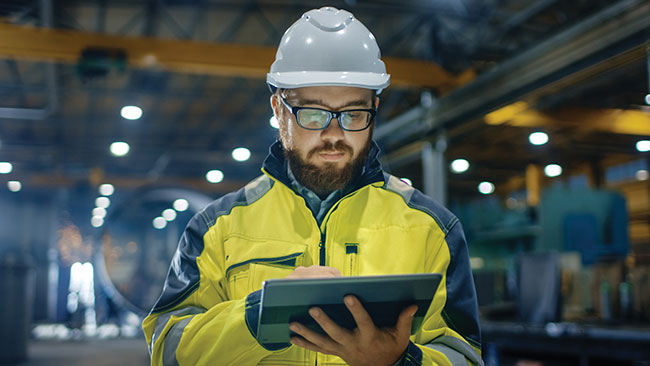
Features
Technology
Technology
More data, more often
The right telematics systems will save you time and money
October 24, 2023 By Elizabeth Bate
 Using third-party telematics systems to connect older equipment can help keep it running longer. Photo provided by Honeywell Forge.
Using third-party telematics systems to connect older equipment can help keep it running longer. Photo provided by Honeywell Forge. None of us is a stranger to technology. More than two decades after the first GPS units were put into heavy construction equipment, we’re used to seeing connected technology — more commonly known as telematics systems — offered on everything from excavators, to screeners and crushers, to haul trucks.
A recent report from Mordor Intelligence says the telematics market for construction machinery is expected to grow from US $1.3 billion in 2023 to US $2.4 billion in 2028 due, in part, to a wider availability of smaller, faster technology.
Edward Olson, product manager, digitalization at John Deere, says while the company has been selling equipment with smart technology included for 20 years, the last few years have seen a significant amount of growth in connected offerings from many OEMs.
“Modem availability and price points that are acceptable to smaller machines let us provide… connectivity across all our machines. In addition, those 4G LTE modems can get more data more often from all those machines,” he said.
The smaller, faster and cheaper availability of 4G and 5G LTE modem technology, in addition to the improvement of sensor technology, has made it easier for manufactures to incorporate connections into their equipment and expand their offerings to customers.
Those sensors can do everything from making maintenance easier and issues detectable sooner, decreasing downtime, to increasing safety for operators and those around them, and providing assisted operation, improving the overall accuracy of a job.
For John Deere those innovations include offering customers excavators with what it calls SmartGrade, a feature that allows operators to receive accurate, real-time information about distance to target grade, including reference information about the design plans such as boundary areas, features of the design, contour break lines, as well as the finish grade surface itself.
“Without Grade Control, these insights were only available on paper plans and visual references like paint lines and grade stakes which are usually destroyed during work and are often out of date,” said Olson.
Having the latest and greatest seems like a good idea, but upgrading a site’s entire lineup to match one connected ecosystem is costly and may be impossible. Olson says one of the challenges facing manufacturers is ensuring their devices can work well together to allow customers to buy from different brands for different needs, or even keep older equipment.
“John Deere machines offer differentiating performance, but they still need to work with other brands on a single jobsite,” he said. “I think that convergence is going to pay off for customers who are looking at their mixed fleet and wanting solutions that work well with one another.”
Connecting everything
Praveen Sam, director of offering management, Honeywell Cybersecurity and Connected Industrials, agrees with Olson.
Honeywell Forge’s line-up of Performance+ analytics systems for heavy construction equipment were designed to be added to machines after purchase. Adding them to older equipment can extend their life while making them part of a connected ecosystem.
“There are multiple ways by which old equipment can still provide necessary data to use advanced software. Sensing platforms allow retrofits on different equipment for connectivity,” Sam said.
Those sensors can provide much of the same information built-in systems can provide, making operations easier and more efficient, and allowing for a more comprehensive maintenance plan.
Stop problems before they start
Maintenance is at the heart of nearly all OEM and third-party telematics systems. Connected devices work together to detect problems using a combination of sensors, math, and statistics and industry standards to model when something is likely to break down. Artificial intelligence (AI) is also playing a key role in new systems.
Sam says mathematical and statistical methods including AI techniques like machine learning help connected customers anticipate a problem with equipment before it begins.
“These insights allow industrial clients to predict things like, what is the remaining useful life, when could an asset reasonably fail, and other aspects such as energy consumption,” Sam said.
“It also enables decisions like how best to produce, how to optimize for reliability and how to reduce maintenance spend.”
Those insights and statistical models can be added to a client’s database and updated remotely, making it easy to keep up with new developments, even using third-party devices.
Predictions about when a machine might fail will allow operators to schedule planned downtime more easily. More scheduled maintenance means more regular uptime and more dollars saved.
Haver & Boecker Niagara service manager Wilm Schulz says any service tool is most effective when paired with a comprehensive, hands-on service approach. Telematics systems, when used effectively, can also allow operators to easily share data with maintenance and repair technicians, dealers and other professionals who can partner to keep an operation moving.
Some telematics systems can allow a technician to fix a problem without setting foot on a job site, says Olson.
“More recently, remote display access and software reprogramming have enabled remote service calls to successfully fix a customer’s machine without requiring a technician visit at all.”

Connected systems can be used to find efficiencies in operations by giving a high-level overview. Photo provided by Haver & Boecker Niagara.
Work smarter, not harder
While maintenance is a big way telematics systems can be used to save money, new technology is making it easier to find the inefficiencies in operations.
Schulz says plant simulation tools offer a high-level view of an entire operation’s workflow. This helps optimize processes and look at opportunities for improvement in both existing sites and new pits or quarries for all mineral processing operations. The software also helps operations spot and fix bottlenecks.
Plant simulation programs take into account the equipment used throughout the plant, from material washers and conveyers to crushers and vibrating screens. The operation’s existing setup, or a proposed setup, is entered into the program to understand and predict overall performance and plant flow. Tools like this are also useful for insights into product specification or production rate changes — such as dry and wet crushing, screening and sorting — and can be used for pre-calculations.
Safety is key
Using math, machine learning and AI to build a better business is the way of the future, but far from removing the human component, Olson says the machines aren’t replacing human operators yet, but are making their jobs safer instead.
“Safety on the jobsite is continually a focus as we integrate vision systems across more of our machines. Starting with rear and surround view vision systems, progressing through object and people detection, and ultimately assisting the machines themselves to help prevent unwanted interactions,” he said.
Those “unwanted interactions” include SmartDetect systems that alert an operator to possible humans or animals in the vicinity of an excavator, and stop operations immediately if they get too close, improving on operator response time and preventing a possible tragedy.
Ensuring those on a job site are safe in and out of the cab should be a key component of any telematics system
being considered. Using connected systems as an additional safety measure makes them a crucial part of any operation, Olson said.
“Connectivity should be viewed as a pre-requisite for much of the value that will come.”
Print this page